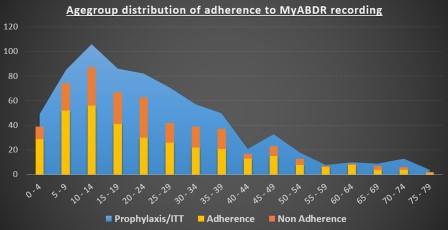SUMIT PARIKH
Sumit Parikh is the AHCDO ABDR Senior Research Fellow

With COVID-19 gripping the entire world, the ISTH Congress, the scientific meeting of the International Society for Thrombosis and Haemostasis that takes place each year, was a virtual experience in 2020. The Australian Haemophilia Centre Directors’ Organisation (AHCDO) had one poster this year, Uptake of MyABDR in Australia, which was very well received, with many positive comments and feedback.

It is well-recognised that care for people with haemophilia has improved much over the last two decades. However, one of the biggest challenges to formally assess the benefit of routine prophylaxis remains the need to regularly monitor adherence and treatment outcomes. The main aim of this project was to review the uptake of MyABDR among haemophilia A patients in Australia: it is imperative to understand how this smartphone and website application is being used to self-record home treatments and bleeds.
Around 30% of haemophilia A patients are registered on MyABDR (including 68% severe and 12% non-severe). Results demonstrated that 75% of MyABDR users are on routine prophylaxis and/or immune tolerisation therapy. To measure approximate ‘adherence to prophylaxis’, the prescribed treatment regimen was compared against product delivered/supplied. To understand how often patients were recording their treatments in the MyABDR app, or ‘adherence to logging’, the prescribed treatment regimen was compared against treatments recorded in MyABDR.
It was very encouraging to observe an upward annual trendline of the adherence to logging curve looking at a time period of almost 6 years, as treatment recording has greatly improved in the last 2 years. Parallel comparison of adherence to prophylaxis and adherence to logging highlighted that patients who are consistently adherent to their treatment regimen and recording in MyABDR benefit the most, as can be seen in evidence from the EHL (Extended Half-Life) Interim Program.

There is a small proportion of patients who persistently do not record in MyABDR. From a community perspective, if we can ascertain any limitations and/or establish reasons why patients do not record, there could be an opportunity to improve the uptake of MyABDR. This would then more accurately reflect the benefits of routine prophylaxis.
MyABDR is a valuable tool to determine the relationship between treatment, outcomes and patient compliance. The quick snapshot in this poster provided a good overview of MyABDR usage in Australia. We intend to undertake further study to evaluate bleeds recorded on MyABDR to improve our understanding of the outcomes and to investigate whether it helps with reviewing and adjusting a patient’s prescribed treatment regimen, if required.
Best wishes to all. Stay safe – and keep recording in MyABDR!
Haemophilia Foundation Australia acknowledges the Traditional Owners and Custodians of Country throughout Australia, the land, waters and community where we walk, live, meet and work. We pay our respects to Elders past and present and extend that respect to all Aboriginal and Torres Strait Islander peoples.
Sign up for the latest news, events and our free National Haemophilia magazine